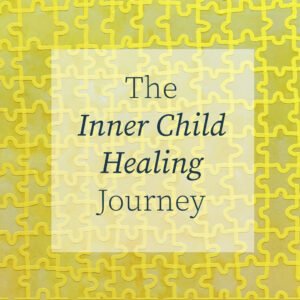
Inner Child Healing (II): Taking Care of Difficult Emotions
Welcome to the second part of our Inner Child Healing Journey, where we will look into difficult emotions! In the first part of the journey, we explored the importance of conflict resolution and we looked at ways to navigate conflict, then applied this to heal what we needed to heal from our childhoods.
Today, we go beyond the surface of conflict, and explore how to caretake difficult emotions that may arise when we are in the midst of a conflictual dynamic.
Let’s begin:
The Importance of Healthy Emotional Expression
As human beings, we are encoded to be able to feel. Emotions are our Soul’s way of communicating to us through our body. It’s all good when we experience Joy or Love, but what about when we are going through the more difficult ones like shame, deep sadness, grief, anger or rage?
Unresolved emotional imbalances can influence us on many levels of existence. Learning how to return to state of inner peace and balance is vital for a healthy life. Healthy emotional expression and dynamics are conducive to a happy and fulfilled life.
I believe that when we learn to resolve the underlying difficult emotions beneath the surface of a conflict, we learn how to be happy and at peace with our Self and in our relationships. I believe that doing this work can contribute to creating a happier and more peaceful society, in which we are truly aligned with our Divine Nature.
Gifting these skills and knowledge to the children of today will help future generations in creating a happier planet, which is why I have created this Inner Child Healing Journey, and my illustrated children’s book After The Storm Comes The Sun.
How To Take Care of Difficult Emotions
When we experience difficult emotions, it can be overwhelming even for us adults, let alone children. In the early stages of human development, it’s difficult to self-regulate and manage difficult emotions. Which is why as parents, caregivers, and educators, it is our responsibility to teach children how to self-regulate their emotions during difficult times.
Here are some strategies that can help children develop the skills they need to take care of themselves during conflicts:
• Recognize and Validate Emotions: The first step in self-regulation is recognizing and acknowledging the emotions that arise during a conflict. Encourage children to express how they feel and assure them that their emotions are valid. Let them know that it’s okay to feel sad, angry, or upset, but it’s important to find healthy ways to deal with these emotions.
• Teach Deep Breathing Techniques: Deep breathing is a simple yet powerful technique that can help children calm their minds and bodies. Encourage them to take slow, deep breaths, counting to four as they inhale and exhale. This practice can help reduce feelings of anger or rage and bring a sense of calmness and clarity.
• Practice Mindfulness: Mindfulness is the practice of being fully present in the moment without judgment. Teach children to focus their attention on their thoughts, feelings, and sensations during conflicts. By practicing mindfulness, they can learn to observe their emotions without becoming overwhelmed by them.
• Encourage Healthy Expression: It’s important for children to understand that it’s okay to express their emotions, but it should be done in a healthy and respectful way. Encourage them to use words to communicate how they feel instead of resorting to aggressive behaviors. Provide them with alternative ways to express themselves, such as through art, writing, or physical activities.
• Teach Problem-Solving Skills: Conflicts often arise from unmet needs or misunderstandings. Help children develop problem-solving skills by teaching them how to identify the underlying issues and find constructive solutions. Encourage them to listen to others’ perspectives, express their own needs and feelings, and work together to find a resolution.
• Model Emotional Regulation: Children learn by observing the behavior of the adults around them. As parents, caregivers, and educators, it is essential to model healthy emotional regulation during conflicts. Show them how to manage your own emotions calmly and respectfully, and they will learn from your example.
• Provide a Safe and Supportive Environment: Creating a safe and supportive environment is crucial for children to feel comfortable expressing their emotions during conflicts. Ensure that they know they can come to you for guidance, reassurance, and understanding. Let them know that mistakes happen, and conflicts can be an opportunity for growth and learning.
Healing Your Inner Child
On the basis of our discussion above, let’s now apply this wisdom to heal our inner child. If you have your photo of you as a child, hold it while you reconnect with him/her.
Ask, is there any unresolved emotional wounding from your childhood that is still influences your life? Is there any sense of resolution that he/she would like to reach? How did difficult emotions get handled in your immediate surroundings when you were a child? Did you learn to express yourself in a healthy way? Were your emotional needs met most of the time as a child? It may be helpful if you use the strategies listed above to help you further in this inner exploration.
Sit in silence for a few moments and listen to the child within you. Let her express all there is to express. And then take a piece of paper and write it all down. When you know what would help your inner child get a sense of resolution, you may consider taking action to do so if it’s appropriate. For example, you may speak aloud to her and re-assure her that she is worthy even when she feels angry. Or, you may guide her to forgive the people she feels have hurt her. You may help her release that old stored trauma.
It may be necessary to repeat this course of action if there are more things to resolve from your childhood. Let your intuition guide you ♡
Learning about Emotions through The Book
In my illustrated children’s book After The Storm Comes The Sun, one of the main themes is learning how to navigate challenging emotions. Through the main character’s experience, we learn about emotional expression, how to handle difficult emotions, and ultimately self-acceptance.
By teaching ourselves how to self-regulate our difficult emotions during conflicts, and by teaching these lessons to future generations, we empower ourselves to navigate challenging situations with more grace and resilience. It may take time and practice to develop these skills, and we may make mistakes sometimes. Even when we make mistakes, we can learn to repair—and we’ll explore this in the next article.
I hope this has been of value to you! If you’ve enjoyed it, I’d love to know. You can always let me know in the comments below ♡
Love,







Comments
No Comments